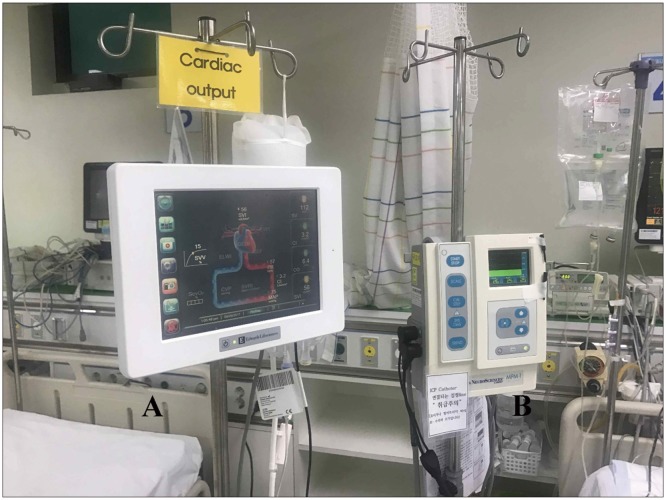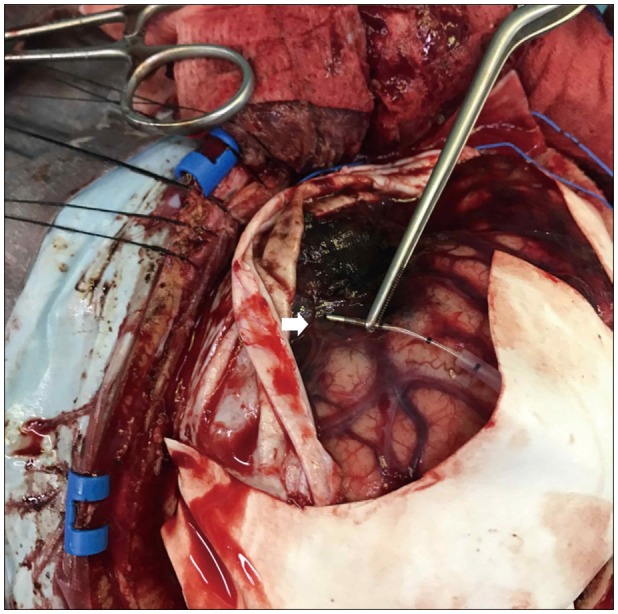Korean J Neurotrauma.
2017 Oct;13(2):96-102. 10.13004/kjnt.2017.13.2.96.
The Combined Use of Cardiac Output and Intracranial Pressure Monitoring to Maintain Optimal Cerebral Perfusion Pressure and Minimize Complications for Severe Traumatic Brain Injury
- Affiliations
-
- 1Department of Neurosurgery, Dankook University Hospital, Dankook University College of Medicine, Cheonan, Korea. tjburk@hanmail.net
- KMID: 2394541
- DOI: http://doi.org/10.13004/kjnt.2017.13.2.96
Abstract
OBJECTIVE
To show the effect of dual monitoring including cardiac output (CO) and intracranial pressure (ICP) monitoring for severe traumatic brain injury (TBI) patiens. We hypothesized that meticulous treatment using dual monitoring is effective to sustain maintain minimal intensive care unit (ICU) complications and maintain optimal ICP and cerebral perfusion pressure (CPP) for severe TBI patiens.
METHODS
We included severe TBI, below Glasgow Coma Scale (GCS) 8 and head abbreviation injury scale (AIS) >4 and performed decompressive craniectomy at trauma ICU of our hospital. We collected the demographic data, head AIS, injury severity score (ISS), initial GCS, ICU stay, sedation duration, fluid therapy related complications, Glasgow Outcome Scale (GOS) at 3 months and variable parameters of ICP and CO monitor.
RESULTS
Thirty patients with severe TBI were initially selected. Thirteen patients were excluded because 10 patients had fixed pupillary reflexes and 3 patients had uncontrolled ICP due to severe brain edema. Overall 17 patients had head AIS 5 except 2 patients and 10 patients (58.8%) had multiple traumas as mean ISS 29.1. Overall complication rate of the patients was 64.7%. Among the parameters of CO monitoring, high stroke volume variation is associated with fluid therapy related complications (p=0.043) and low cardiac contractibility is associated with these complications (p=0.009) statistically.
CONCLUSION
Combined use of CO and ICP monitors in severe TBI patients who could be necessary to decompressive craniectomy and postoperative sedation is good alternative methods to maintain an adequate ICP and CPP and reduce fluid therapy related complications during postoperative ICU care.
Keyword
MeSH Terms
Figure
Reference
-
1. Aiolfi A, Benjamin E, Khor D, Inaba K, Lam L, Demetriades D. Brain trauma foundation guidelines for intracranial pressure monitoring: Compliance and effect on outcome. World J Surg. 2017; 41:1543–1549. PMID: 28188356.
Article2. Piccinini A, Lewis M, Benjamin E, Aiolfi A, Inaba K, Demetriades D. Intracranial pressure monitoring in severe traumatic brain injuries: a closer look at level 1 trauma centers in the United States. Injury. 2017; 48:1944–1950. PMID: 28495204.
Article3. Bratton SL, Davis RL. Acute lung injury in isolated traumatic brain injury. Neurosurgery. 1997; 40:707–712. PMID: 9092843.
Article4. Burke AM, Quest DO, Chien S, Cerri C. The effects of mannitol on blood viscosity. J Neurosurg. 1981; 55:550–553. PMID: 6792325.
Article5. Button D, Weibel L, Reuthebuch O, Genoni M, Zollinger A, Hofer CK. Clinical evaluation of the FloTrac/Vigileo system and two established continuous cardiac output monitoring devices in patients undergoing cardiac surgery. Br J Anaesth. 2007; 99:329–336. PMID: 17631509.6. Carney N, Totten AM, O'Reilly C, Ullman JS, Hawryluk GW, Bell MJ, et al. Guidelines for the Management of Severe Traumatic Guidelines for the management of severe traumatic brain injury, fourth edition. Neurosurgery. 2017; 80:6–15. PMID: 27654000.8. Davison DL, Terek M, Chawla LS. Neurogenic pulmonary edema. Crit Care. 2012; 16:212. PMID: 22429697.
Article9. Kipnis E, Ramsingh D, Bhargava M, Dincer E, Cannesson M, Broccard A, et al. Monitoring in the intensive care. Crit Care Res Pract. 2012; 2012:473507. PMID: 22970356.
Article10. Lee K. The neuroICU book. New York, NY: McGraw-Hill;2012.11. Mayer J, Boldt J, Wolf MW, Lang J, Suttner S. Cardiac output derived from arterial pressure waveform analysis in patients undergoing cardiac surgery: validity of a second generation device. Anesth Analg. 2008; 106:867–872. PMID: 18292432.12. McGee WT. A simple physiologic algorithm for managing hemodynamics using stroke volume and stroke volume variation: physiologic optimization program. J Intensive Care Med. 2009; 24:352–360. PMID: 19736180.
Article13. Mehta Y, Chand RK, Sawhney R, Bhise M, Singh A, Trehan N. Cardiac output monitoring: comparison of a new arterial pressure waveform analysis to the bolus thermodilution technique in patients undergoing off-pump coronary artery bypass surgery. J Cardiothorac Vasc Anesth. 2008; 22:394–399. PMID: 18503927.
Article14. Muizelaar JP, Lutz HA 3rd, Becker DP. Effect of mannitol on ICP and CBF and correlation with pressure autoregulation in severely head-injured patients. J Neurosurg. 1984; 61:700–706. PMID: 6432972.
Article15. Muizelaar JP, Ward JD, Marmarou A, Newlon PG, Wachi A. Cerebral blood flow and metabolism in severely head-injured children. Part 2: Autoregulation. J Neurosurg. 1989; 71:72–76. PMID: 2738644.16. Muizelaar JP, Wei EP, Kontos HA, Becker DP. Mannitol causes compensatory cerebral vasoconstriction and vasodilation in response to blood viscosity changes. J Neurosurg. 1983; 59:822–828. PMID: 6413661.
Article17. Prasser C, Bele S, Keyl C, Schweiger S, Trabold B, Amann M, et al. Evaluation of a new arterial pressure-based cardiac output device requiring no external calibration. BMC Anesthesiol. 2007; 7:9. PMID: 17996086.
Article18. Scheeren TW, Wiesenack C, Compton FD, Zukunft B, Hoffmann C, Zidek W, et al. Performance of a minimally invasive cardiac output monitoring system (Flotrac/Vigileo). Br J Anaesth. 2008; 101:279–280. PMID: 18614598.
Article19. Talving P, Karamanos E, Teixeira PG, Skiada D, Lam L, Belzberg H, et al. compliance with Brain Trauma Foundation guidelines and effect on outcomes: a prospective study. J Neurosurg. 2013; 119:1248–1254. PMID: 23971954.20. Yeo LL, Seow SC, Loh JP, Phua J. Comparison of cardiac output measurement by arterial waveform analysis and pulmonary artery catheter in mitral stenosis. Ann Acad Med Singapore. 2010; 39:655–657. PMID: 20838709.
- Full Text Links
- Actions
-
Cited
- CITED
-
- Close
- Share
- Similar articles
-
- Cerebral perfusion pressure optimization for the regulation of brain edema and intracranial pressure
- Anesthetic management of the traumatic brain injury patients undergoing non-neurosurgery
- Effects of Cutaneous Burn Injury and Resuscitation on the Cerebral Circulation
- Management of Head Injury in the Emergency Department
- Medical managements of intracranial hypertension



